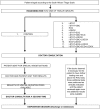Doctors' perceptions of the impact of upfront point-of-care testing in the emergency department
- PMID: 30543668
- PMCID: PMC6292565
- DOI: 10.1371/journal.pone.0208655
Doctors' perceptions of the impact of upfront point-of-care testing in the emergency department
Erratum in
-
Correction: Doctors' perceptions of the impact of upfront point-of-care testing in the emergency department.PLoS One. 2019 Jan 29;14(1):e0211672. doi: 10.1371/journal.pone.0211672. eCollection 2019. PLoS One. 2019. PMID: 30695075 Free PMC article.
Abstract
Objectives: Special investigations (e.g. blood tests, electrocardiograms, x-rays) play an integral role in patient management in the emergency department (ED). Having results immediately available prior to assessing a patient may lead to improved efficiency. This could be instituted by utilizing point-of-care (POC) testing with an alternative ED workflow, but the implementation would be dependent on acceptance by the end-users. The aim of this study was to assess doctors' perceptions of POC testing in the ED when the normal treatment pathway was modified to use upfront POC tests performed prior to doctor evaluation in an effort to decrease treatment times.
Methods: A prospective, randomized, controlled trial was performed in the ED where medical patients received either the normal ED workflow pathway or one of the enhanced workflow pathways with POC tests in various combinations prior to doctor evaluation. At the end of the study period, doctors were invited to participate in an anonymous survey to gauge their opinions on the implementation of the early POC testing.
Results: Overall, the doctors surveyed were very satisfied with use of upfront POC in the ED. One hundred per cent of the 28 doctors surveyed found it helpful to assess patients who already had test results available and would want it to be permanently available. Normalized satisfaction scores were more favorable for combinations of 3 or more tests (0.7-1.0) as opposed to combinations with 2 or less tests (0.3-0.7). There was a preference for combinations that included comprehensive blood results.
Conclusion: The implementation of workflow changes to assist doctors in the ED can potentially make them more productive. End-user buy-in is essential in order for the change to be successful. Upfront, protocolised, POC testing is a low-input, high-yield intervention that decreased treatment time and satisfied doctors.
Conflict of interest statement
The authors have declared that no competing interests exist.
Figures




Similar articles
-
The cost-effectiveness of upfront point-of-care testing in the emergency department: a secondary analysis of a randomised, controlled trial.Scand J Trauma Resusc Emerg Med. 2019 Dec 11;27(1):110. doi: 10.1186/s13049-019-0687-2. Scand J Trauma Resusc Emerg Med. 2019. PMID: 31829227 Free PMC article. Clinical Trial.
-
A Randomized Controlled Trial to Assess the Impact of Upfront Point-of-Care Testing on Emergency Department Treatment Time.Am J Clin Pathol. 2018 Jul 31;150(3):224-234. doi: 10.1093/ajcp/aqy042. Am J Clin Pathol. 2018. PMID: 29931184
-
Doctors', Patients' and Physician Associates' Perceptions of the Physician Associate Role in the Emergency Department.Health Expect. 2024 Aug;27(4):e14135. doi: 10.1111/hex.14135. Health Expect. 2024. PMID: 38984378 Free PMC article.
-
Point-of-care Cognitive Support Technology in Emergency Departments: A Scoping Review of Technology Acceptance by Clinicians.Acad Emerg Med. 2018 May;25(5):494-507. doi: 10.1111/acem.13325. Epub 2017 Nov 8. Acad Emerg Med. 2018. PMID: 28960689
-
The potential of point-of-care diagnostics to optimise prehospital trauma triage: a systematic review of literature.Eur J Trauma Emerg Surg. 2023 Aug;49(4):1727-1739. doi: 10.1007/s00068-023-02226-8. Epub 2023 Jan 26. Eur J Trauma Emerg Surg. 2023. PMID: 36703080 Free PMC article.
Cited by
-
The cost-effectiveness of upfront point-of-care testing in the emergency department: a secondary analysis of a randomised, controlled trial.Scand J Trauma Resusc Emerg Med. 2019 Dec 11;27(1):110. doi: 10.1186/s13049-019-0687-2. Scand J Trauma Resusc Emerg Med. 2019. PMID: 31829227 Free PMC article. Clinical Trial.
-
Benefits of emergency department routine blood test performance on patients whose allocated triage category is not time critical: a retrospective study.BMC Health Serv Res. 2024 Oct 17;24(1):1252. doi: 10.1186/s12913-024-11612-w. BMC Health Serv Res. 2024. PMID: 39420308 Free PMC article.
-
Point-of-care COVID-19 testing in the emergency department: current status and future prospects.Expert Rev Mol Diagn. 2021 Dec;21(12):1333-1340. doi: 10.1080/14737159.2021.2005582. Epub 2021 Nov 29. Expert Rev Mol Diagn. 2021. PMID: 34758686 Free PMC article. Review.
-
Correction: Doctors' perceptions of the impact of upfront point-of-care testing in the emergency department.PLoS One. 2019 Jan 29;14(1):e0211672. doi: 10.1371/journal.pone.0211672. eCollection 2019. PLoS One. 2019. PMID: 30695075 Free PMC article.
-
Physician Communication Behaviors on Patient Satisfaction in Primary Care Medical Settings in Bangladesh.J Prim Care Community Health. 2024 Jan-Dec;15:21501319241277396. doi: 10.1177/21501319241277396. J Prim Care Community Health. 2024. PMID: 39327849 Free PMC article.
References
-
- Seow E. Leading and managing an emergency department—a personal view. J Acute Med. 2013. 3:61–66. 10.1016/j.jacme.2013.06.001 - DOI - PMC - PubMed
-
- Lee-Lewandrowski E, Corboy D, Lewandrowski K, Sinclair J, McDermot S, Benzer TI. Implementation of a point-of-care satellite laboratory in the emergency department of an academic medical center. Arch Pathol Lab Med. 2003. April;127(4):456–460. - PubMed
-
- Oredsson S, Jonsson H, Rognes J, Lind L, Göransson KE, Ehrenberg A et al. A systematic review of triage-related interventions to improve patient flow in emergency departments. Scand J Trauma Resusc Emerg Med. 2011. July 19;19:43 10.1186/1757-7241-19-43 - DOI - PMC - PubMed
-
- Fermann GJ, Suyama J. Point of care testing in the emergency department. J Emerg Med. 2002. May;22(4):393–404. 10.1016/s0736-4679(02)00429-8 - DOI - PubMed
-
- Mogensen CB, Borch A, Brandslund I. Point of care technology or standard laboratory service in an emergency department: is there a difference in time to action? A randomised trial. Scand J Trauma Resusc Emerg Med. 2011. 19:49 10.1186/1757-7241-19-49 - DOI - PMC - PubMed
Publication types
MeSH terms
LinkOut - more resources
Full Text Sources
Medical

